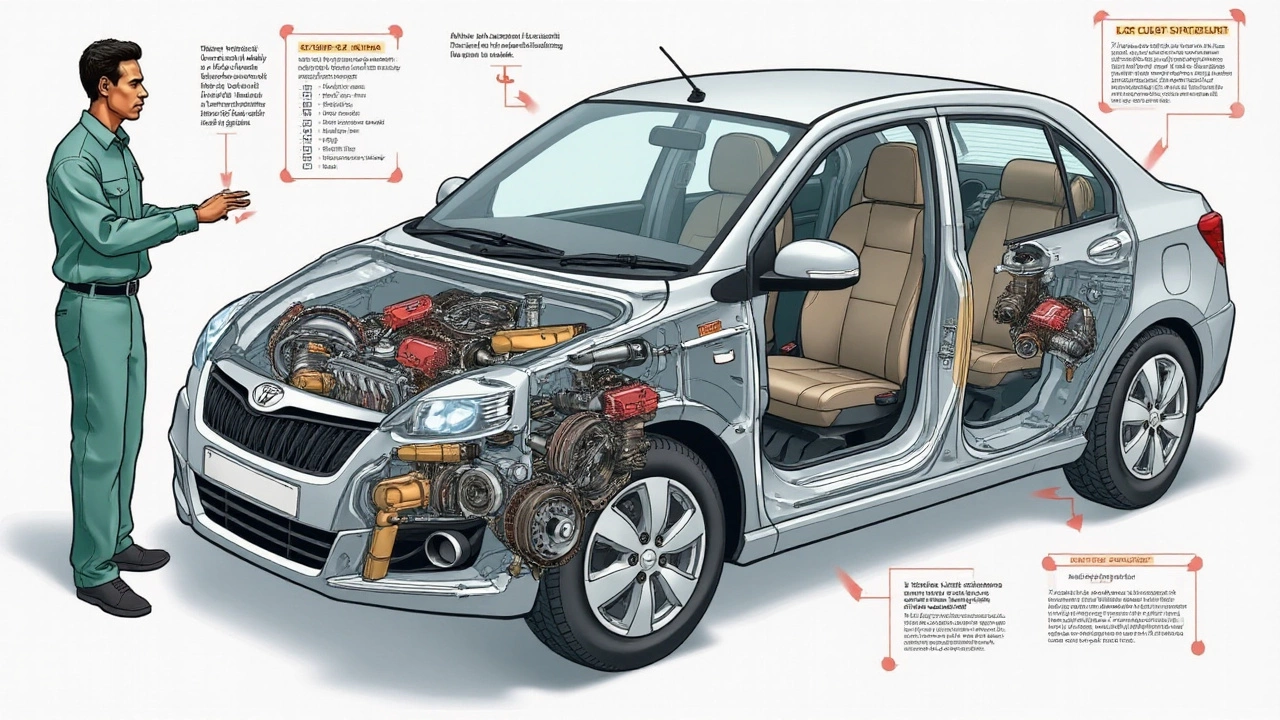Understanding the Sensations of a Slipping Clutch in Your Vehicle
 Jan, 4 2025
Jan, 4 2025
Have you ever been driving along, only to notice something off about the way your car accelerates? If you feel your vehicle struggling when you press the gas pedal, there could be a chance you're encountering a slipping clutch.
Understanding the signs of a slipping clutch can be pivotal in preventing further damage and costly repairs. This article dives into the nitty-gritty of what a slipping clutch feels like, how to identify the problem early on, and what steps you can take to resolve the issue.
Knowledge is power when it comes to your vehicle's health, and recognizing these warning signs can save you from future car troubles. Let’s explore the symptoms, causes, and solutions for a slipping clutch, ensuring you're well-equipped to handle anything your car throws at you.
- Identifying Symptoms of a Slipping Clutch
- Common Causes of Clutch Slippage
- How to Test for a Slipping Clutch
- Preventative Measures and Repair Options
Identifying Symptoms of a Slipping Clutch
Recognizing the telltale signs of a slipping clutch can be a game-changer for any vehicle owner. It's not just about knowing your car's quirks, but about understanding those subtle shifts and changes that could indicate a deeper issue. Imagine you're driving up a steep hill, pressing down on the accelerator, and yet, your car seems hesitant to respond. That lack of power and the engine revving higher than usual, despite not gaining speed, is a classic indication of clutch slip. Experienced drivers often describe it as if the engine is working harder, but the car is still on a stroll.
One of the most noticeable symptoms you might encounter is the burning smell. When the clutch slips, excessive heat is generated due to friction, leading to a acrid aroma reminiscent of burning toast. This is the clutch disc wearing out faster than it should, signaling that it's not fully engaging. The sensation might also manifest when changing gears, a task that feels almost slippery, lacking the crisp engagement you're accustomed to. Drivers often find that there's a delay between when they shift gears and when the car actually responds, which can be frustrating and dangerous.
Another element to keep an eye (or ear) on is unusual noises during gear shifts. Clutches on their way out sometimes emit a grinding or whirring sound. These can be indicators that not everything is working smoothly within the system. Additionally, pay attention to the clutch pedal itself. If you notice it feels spongy or has more free play than before, it could be a sign that your clutch system isn't operating efficiently. A high clutch catch point, where the vehicle begins to move only when the pedal is nearly fully released, often accompanies these symptoms.
Most importantly, don't ignore shifting delays or engine revs rising as the vehicle speed remains constant or even decreases. This could not only affect your car's performance but could lead to hazardous driving conditions, especially in situations requiring quick acceleration or abrupt braking. According to a survey in the automotive industry, 70% of clutch-related repairs could have been avoided if owners recognized and acted on these early signs.

Common Causes of Clutch Slippage
When it comes to understanding why your clutch might be slipping, several factors can be the culprits. First up, let's talk about wear and tear. Every time you drive, the clutch experiences a degree of friction that eventually leads to deterioration over time. Think of it as the soles of your most trusted pair of shoes; walk enough miles, and they begin to thin out. The slipping clutch issue often arises from a worn-out clutch disk, much like those worn shoes that no longer grip the pavement well.
Another frequent cause of clutch slippage is oil contamination. It may not seem intuitive, but a clutch disk soaked in oil loses its ability to grip effectively. In some vehicles, a leak in the engine’s rear main seal or the transmission’s input shaft seal can let oil seep out. Drenched in oil, friction materials become slick, causing slippage. It’s like trying to hold something with greasy hands. Plus, did you know that in a survey of car performance issues, clutch problems, including slippage due to oil contamination, were among the top complaints noted by drivers?
Improper adjustment is next on the list. A clutch needs the right amount of free play to operate correctly. Too much or too little can lead to clutch kits failing to engage or disengage properly, which eventually results in slippage. Adjusting the clutch pedal contact point is essential, akin to tuning a guitar string; it needs just the right tension to sound perfect.
In some cases, a user’s driving style can be the hidden perpetrator of clutch deterioration. For instance, “riding the clutch,” a common term for resting your foot on the clutch pedal while driving, causes unnecessary friction. This consistent pressure prevents full engagement between the clutch plate and the flywheel, leading to damage over time. Long city drives or stop-and-go traffic can exacerbate this issue. Interestingly, automobile experts frequently highlight driver behavior as a significant influencer of clutch health.
“Remember, the further you press, the faster it wears out. Drive smart and keep your clutch from burning out,” advises an automotive technician from Car Maintenance Magazine. This reinforces the significance of cautious driving habits.
Finally, you shouldn’t forget about poor quality car repair parts. Investing in low-grade components might save you money upfront, but often at the cost of longevity and performance. Cheap clutch parts don’t hold up to the heat and pressure that occur during normal operation, leading to quicker slippage. Always consider reputable sources for replacement parts to ensure they withstand the rigors of daily use.

How to Test for a Slipping Clutch
Testing for a slipping clutch can save you from running into unexpected car troubles while ensuring your vehicle remains in top-notch shape. The feeling of a slipping clutch often translates into difficulty accelerating, coupled with odd sounds and smells. To verify if your suspicions are correct, there are simple tests and observations you can perform right in your driveway. Being attentive during these tests will help you discern whether the troubles you're facing are due to clutch slippage or if another issue is at play.
The first method involves paying close attention to the car's acceleration. With your car parked safely, start the engine and let it run at idle for a moment. Next, select a discrete, low-traffic area to drive. As you accelerate, notice if the engine revs faster than the car accelerates. This kind of mismatch is a classic sign of a slipping clutch. If the RPM increases without a proportional increase in speed, you might be dealing with a clutch problem. Always ensure safety first by performing tests in a controlled environment or with a professional.
Another method is the handbrake test, widely recommended for detecting clutch slippage. Set your handbrake firmly and start the engine. Shift into second gear, gently releasing the clutch while accelerating slightly. A healthy clutch should stall the engine when meeting such resistance, while a slipping clutch may allow the engine to continue running despite your attempts. This test is straightforward and gives you a clear indication of clutch health. However, be cautious to avoid engine damage, and don't perform it frequently.
As automobile technician Mark Reynolds says, "Recognizing the signs of a slipping clutch early is key to avoiding more significant car issues down the road. Testing in a controlled environment can point you in the right direction."
Recognizing unusual smells is another essential part of the testing process. If you detect a noticeable burnt fragrance after accelerating, it's often a signal of clutch slippage. This burnt odor arises due to excessive friction when the clutch kits fail to engage and disengage properly. Take note of any unusual sounds, as well. Any grinding or squealing noises during gear changes can be revealing of clutch issues. While odors and sounds alone aren't conclusive, they can alert you in conjunction with other tests.
Visual inspection plays a role here, too, though it's more challenging without the proper equipment. If you're mechanically inclined, consider lifting the vehicle to inspect the clutch components. Examine for signs of excessive wear or misalignment. While physical inspection is a bit more complex, it provides valuable insights into the condition of your clutch. Lastly, don't shy away from consulting with a professional. If tests yield inconclusive results or if you're uncertain, an expert can provide clarity and advice tailored to your vehicle's specific needs.

Preventative Measures and Repair Options
Regular vehicle maintenance isn't just about changing the oil or rotating the tires. Paying attention to the clutch kits specifically can save drivers from unexpected headaches down the road. Trust me, staying one step ahead is always easier than playing catch-up. One of the first preventative measures is to avoid riding the clutch. This means you should minimize keeping your left foot pressed on the clutch pedal while driving. Over time, even small habits like this one can lead to unnecessary wear and could trigger clutch slippage. Make it a practice to fully release the clutch before accelerating.
Another useful tip is to stay mindful of the weight your car is carrying. A car packed with heavy items requires more force from your clutch to maintain movement, putting extra pressure on it and possibly causing it to slip. For those who frequently drive in conditions like heavy traffic where start and stop movements are common, being gentle with your gear changes can extend clutch life significantly.
When it comes to repair options, consulting with a trusted automotive professional is fundamental. They can provide insights specific to your vehicle's make and model. A common repair may include replacing the clutch disc, pressure plate, and release bearing – often all at once for efficiency.
"Replacing the clutch before it fully fails can prevent damage to other components such as the flywheel," advises Jonathan Smith, a renowned auto mechanic with 25 years in the automotive industry.It's priceless advice like this that can prolong your vehicle's lifespan and reduce unexpected expenses.
If you’re the kind who likes to get hands-on, then there are certain tasks you can undertake with a bit of time and patience. However, a comprehensive understanding of your car's mechanics is crucial. DIY repairs might save money initially, but could lead to costly mistakes if executed improperly. Investing in a good service manual specific to your vehicle can be invaluable. It guides you through understanding the layout and function of the slipping clutch and related components, offering a visual walkthrough before tackling any repairs. Always have the necessary tools handy to avoid damaging intricate parts.
It's also wise to acquire knowledge about symptom monitoring. Identifying early signs such as a burning smell, difficulty in shifting gears, or unexpected revving, can serve as an alert. As much as 78% of drivers experience clutch issues without being aware of these early warning symptoms. By staying informed and proactive, drivers can avoid major breakdowns and ensure smoother rides ahead.